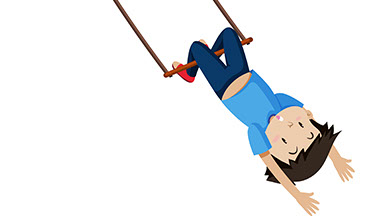As you plan your family’s summer activities, be sure your child has time each day for play. Play is important to a child’s mental and physical health. It helps children manage stress, develop self-regulation skills and make social connection. The American Academy of Pediatrics recommends that pediatricians even write prescriptions for “play.” It’s that critical to a child’s health and well-being.
Try to incorporate the following types of play into your child’s day on a regular basis:
One-on-One Parent/Child Playtime
One-on-one parent/child playtime is sometimes called “Special Playtime.” It is nurturing and stress relieving for both parent and child. This type of playtime works well for children younger than about 8 years old but can be adapted for older children. Here’s how to conduct Special Playtime:
- Set aside 5 to 20 minutes per day, every day, to engage in this activity. Set a timer. End the session when the timer goes off.
- Make plans for keeping other children in the household occupied so Special Playtime will not be disturbed. Turn your phone off or put it in another room.
- Ask your child to choose an activity for Special Playtime. Start with Legos, blocks or an art project, such as drawing. Allow your child to direct the activity. Don’t make suggestions or give instructions.
- Play along with your child. Imitate her actions. For example, if she builds a pyramid with Legos, you build a pyramid too.
- Focus on your child. Give him your undivided attention.
- Communication during Special Playtime is very targeted. Give specific praise, such as “You are very creative in the colors you choose.” Describe what your child is doing. “You are building that tower very tall.” Repeat what your child says so he knows you are listening. If he says, “I need the yellow color for my flower,” you might simply note, “You are coloring your flower yellow.” Avoid other types of conversation during Special Playtime.
- Don’t ask questions or give suggestions. If your child asks you what to do, reply, “What do you think?” Don’t give commands, such as “Let’s play with something else.”
- Avoid critical comments. Don’t disapprove of your child’s behavior or put your child down. If your child misbehaves, end the session. Say, “Special Playtime is over for today. We’ll do it again tomorrow.”
- Make this a special time you enjoy with your child.
Unstructured Outdoor Play
Try to schedule time for unstructured outdoor play as often as possible. Spending time outdoors is good for the whole family. Some experts recommend that children get at least 3 hours of outdoor play each day.
Unstructured outdoor play has many benefits:
- Running around outside gives children much needed physical activity. Childhood obesity rates are rising because of sedentary lifestyles. Going outdoors gets your child off the sofa and into action.
- Spending time outdoors decreases the time your child spends staring at a screen. The more time outdoors, the less time is available for watching TV or playing video games.
- Being in nature engages all of the senses. Children love to pick up rocks, leaves and sticks. They have a chance to watch birds and look for bugs. Focusing on the natural world reduces stress. It helps us appreciate nature and develop respect for the environment.
- Playing outside helps children sleep better because of increased physical activity. After a good night’s sleep, children are more rested, are in a better mood and have improved concentration.
Physical Play With Other Children
Physical play develops both motor and social skills. On the playground, children learn to negotiate with each other to take turns. They build confidence by pushing their boundaries in a safe environment. The thrill of going down a tall slide for the very first time is a memory that lasts a lifetime. Pickup neighborhood games, such as basketball or soccer, can teach sportsmanship and empathy for others. Of course, physical play gives children the exercise that they need to be healthy too.
Creative Play
Creative play can take many forms. Children love to play “pretend” and try out different social roles. They play mommy to their dolls or pretend to be a fireman while watering the flowerbed. Keep a “dress up box” of old Halloween costumes, evening wear, fake fur accessories and the like. These are great props for a play or parade around the house.
Creative play can foster interest in the arts. Provide simple instruments so children can make music. Stock an “art corner” with paper, crayons, markers, glue, tape and child scissors. Suggest making art for a hallway “exhibition” or to give to an elderly neighbor. Play music or dance videos and encourage your child to move with the music.
Brenda Schoolfield is a freelance medical writer based in Austin.














